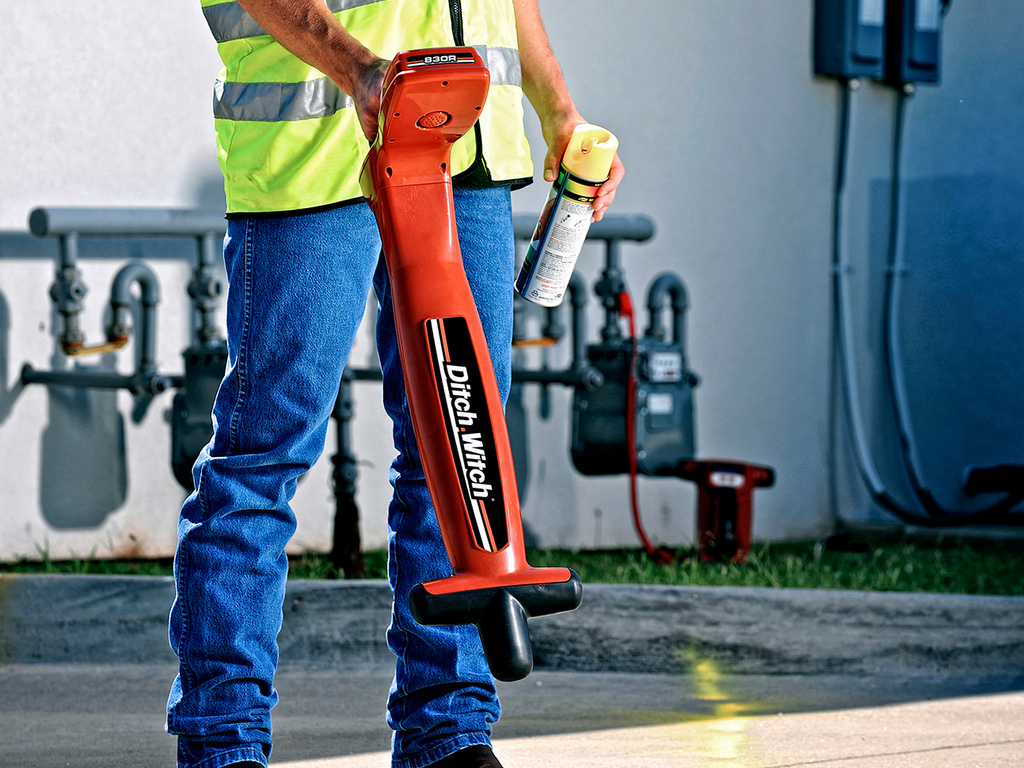|
Pipe Marking
In the process industry, chemical industry, manufacturing industry, and other commercial and industrial contexts, pipe marking is used to identify the contents, properties and flow direction of fluids in piping. It is typically carried out by marking piping through labels and color codes. Pipe marking helps personnel and fire response teams identify the correct pipes for operational, maintenance or emergency response purposes. Background Pipes are used extensively in commercial and industrial buildings and on industrial plant (e.g. oil refineries) to transfer fluids between items of plant and equipment. Positive identification assists operations personnel to correctly identify plant when carrying out routine or maintenance activities, and for emergency personnel when responding to emergencies. Pipe marking is particularly important for identification where pipes run along pipe racks, through walls and bulkheads and through floors. A range of corporate, national and interna ... [...More Info...] [...Related Items...] OR: [Wikipedia] [Google] [Baidu] |
Utility Location
Utility locating is the process of identifying and labeling public utility mains that are underground. These mains may include lines for telecommunication, electricity, electricity distribution, natural gas, cable television, optical fibers, fiber optics, traffic lights, street lights, storm drains, water supply network, water mains, and wastewater pipes. In some locations, major pipeline transport, oil and gas pipelines, national defense communication lines, public transport, mass transit, rail, and road tunnels also compete for space underground. Overview Public utility systems are often run underground—some by the very nature of their function, others for convenience or aesthetics. In the United States, it is estimated that subsurface lines amount to over in total. Before digging, local governments often require that the underground systems' locations be denoted and approved, if it is to be in the public Right-of-way (transportation), right-of-way. Pipeline markers, signs ... [...More Info...] [...Related Items...] OR: [Wikipedia] [Google] [Baidu] |
Globally Harmonized System Of Classification And Labelling Of Chemicals
The Globally Harmonized System of Classification and Labelling of Chemicals (GHS) is an internationally agreed-upon standard managed by the United Nations that was set up to replace the assortment of hazardous material classification and labelling schemes previously used around the world. Core elements of the GHS include standardized hazard testing criteria, universal warning pictograms, and safety data sheets which provide users of dangerous goods relevant information with consistent organization. The system acts as a complement to the UN numbered system of regulated hazardous material transport. Implementation is managed through the UN Secretariat. Although adoption has taken time, as of 2017, the system has been enacted to significant extents in most major countries of the world. This includes the European Union, which has implemented the United Nations' GHS into EU law as the CLP Regulation, and United States Occupational Safety and Health Administration standards. History B ... [...More Info...] [...Related Items...] OR: [Wikipedia] [Google] [Baidu] |
Firewater Marking
Firewater may refer to: Liquid * High-proof beverages, particularly illegal moonshine * Firewater (fire fighting), the polluted water remaining after fire fighting * Fire water, water stored in tanks for wildfire suppression Art and entertainment * Firewater (band), a US indie rock group founded by Tod A. in 1995 * ''Firewater'' (film), Hardi Volmer's Estonian history-based thriller * ''Firewater'' (Tha Alkaholiks album), 2006 * ''Firewater'' (Silkworm album), 1996 * ''Firewater'' (Whiskey Myers album), 2011 * Firewater Studios, digital recording studio See also * Fire and Water (other) Fire and Water may refer to: * ''Fire and Water'' (sculpture), a 1988 artwork in Milwaukee, Wisconsin Film and TV * Fire and Water (Lexx), a location in the TV series ''Lexx'' * "Fire + Water" (''Lost''), a 2006 episode of the television series '' ... * Firewater myths {{disambiguation ... [...More Info...] [...Related Items...] OR: [Wikipedia] [Google] [Baidu] |
Bulkhead (partition)
A bulkhead is an upright wall within the hull (watercraft), hull of a ship, within the fuselage of an airplane, or a car. Other kinds of partition elements within a ship are deck (ship), decks and deckheads. Etymology The word ''bulki'' meant "cargo" in Old Norse. During the 15th century sailors and builders in Europe realized that walls within a vessel would prevent cargo from shifting during passage. In shipbuilding, any vertical panel was called a head. So walls installed abeam (side-to-side) in a vessel's hull were called "bulkheads". Now, the term bulkhead applies to every vertical panel aboard a ship, except for the hull itself. History Bulkheads were known to the ancient Greeks, who employed bulkheads in triremes to support the back of rams. By the Athenian trireme era (500 BC), the hull was strengthened by enclosing the bow behind the ram, forming a bulkhead compartment. Instead of using bulkheads to protect ships against rams, Greeks preferred to reinforce the hull ... [...More Info...] [...Related Items...] OR: [Wikipedia] [Google] [Baidu] |
Asphyxia
Asphyxia or asphyxiation is a condition of deficient supply of oxygen to the body which arises from abnormal breathing. Asphyxia causes generalized hypoxia, which affects all the tissues and organs, some more rapidly than others. There are many circumstances that can induce asphyxia, all of which are characterized by the inability of a person to acquire sufficient oxygen through breathing for an extended period of time. Asphyxia can cause coma or death. In 2015, about 9.8 million cases of unintentional suffocation occurred which resulted in 35,600 deaths. The word asphyxia is from Ancient Greek "without" and , "squeeze" (throb of heart). Causes Situations that can cause asphyxia include but are not limited to: airway obstruction (such as from asthma, laryngospasm, or simple blockage from the presence of foreign materials); from being in environments where oxygen is not readily accessible: such as underwater, in a low oxygen atmosphere, or in a vacuum; environments where s ... [...More Info...] [...Related Items...] OR: [Wikipedia] [Google] [Baidu] |
Oxidizing Agent
An oxidizing agent (also known as an oxidant, oxidizer, electron recipient, or electron acceptor) is a substance in a redox chemical reaction that gains or " accepts"/"receives" an electron from a (called the , , or ''electron donor''). In other words, an oxidizer is any substance that oxidizes another substance. The oxidation state, which describes the degree of loss of electrons, of the oxidizer decreases while that of the reductant increases; this is expressed by saying that oxidizers "undergo reduction" and "are reduced" while reducers "undergo oxidation" and "are oxidized". Common oxidizing agents are oxygen, hydrogen peroxide, and the halogens. In one sense, an oxidizing agent is a chemical species that undergoes a chemical reaction in which it gains one or more electrons. In that sense, it is one component in an oxidation–reduction (redox) reaction. In the second sense, an oxidizing agent is a chemical species that transfers electronegative atoms, usually oxygen, t ... [...More Info...] [...Related Items...] OR: [Wikipedia] [Google] [Baidu] |
Medical Gas Supply
Medical gas supply systems in hospitals and other healthcare facilities are utilized to supply specialized gases and gas mixtures to various parts of the facility. Products handled by such systems typically include: *Oxygen *Medical air *Nitrous oxide *Nitrogen *Carbon dioxide *Suction (medicine), Medical vacuum *Scavenger system, Waste anaesthetic gas disposal (US) or anaesthetic gas scavenging system (ISO) Source equipment systems are generally required to be monitored by alarm systems at the point of supply for abnormal (high or low) gas pressure in areas such as general ward, operating theatres, intensive care units, recovery rooms, or major treatment rooms. Equipment is connected to the medical gas pipeline system via Station Outlet, station outlets (US) or terminal units (ISO). Medical gas systems are commonly color code, color coded to identify their contents, but as coding systems and requirements (such as those for bottled gas) vary by jurisdiction, the text or labeli ... [...More Info...] [...Related Items...] OR: [Wikipedia] [Google] [Baidu] |
National Fire Protection Association
The National Fire Protection Association (NFPA) is a U.S.-based international nonprofit organization devoted to eliminating death, injury, property damage, and economic loss due to fire, electrical, and related hazards. , the NFPA claims to have 50,000 members and 9,000 volunteers working with the organization through its 250 technical committees. History In 1895, a Committee on Automatic Sprinkler Protection was formed in Massachusetts by men affiliated with several fire insurance companies and a pipe manufacturer to develop a uniform standard for the design and installation of fire sprinkler systems. At the time, there were nine such standards in effect within of Boston, Massachusetts, and such diversity was causing great difficulties for plumbers working in the New England New England is a region consisting of six states in the Northeastern United States: Connecticut, Maine, Massachusetts, New Hampshire, Rhode Island, and Vermont. It is bordered by the state of New Y ... [...More Info...] [...Related Items...] OR: [Wikipedia] [Google] [Baidu] |
State Of Matter
In physics, a state of matter is one of the distinct forms in which matter can exist. Four states of matter are observable in everyday life: solid, liquid, gas, and Plasma (physics), plasma. Different states are distinguished by the ways the component particles (atoms, molecules, ions and electrons) are arranged, and how they behave collectively. In a solid, the particles are tightly packed and held in fixed positions, giving the material a definite shape and volume. In a liquid, the particles remain close together but can move past one another, allowing the substance to maintain a fixed volume while adapting to the shape of its container. In a gas, the particles are far apart and move freely, allowing the substance to expand and fill both the shape and volume of its container. Plasma is similar to a gas, but it also contains charged particles (ions and free electrons) that move independently and respond to electric and magnetic fields. Beyond the classical states of matter, ... [...More Info...] [...Related Items...] OR: [Wikipedia] [Google] [Baidu] |
Ammonia
Ammonia is an inorganic chemical compound of nitrogen and hydrogen with the chemical formula, formula . A Binary compounds of hydrogen, stable binary hydride and the simplest pnictogen hydride, ammonia is a colourless gas with a distinctive pungent smell. It is widely used in fertilizers, refrigerants, explosives, cleaning agents, and is a precursor for numeous chemicals. Biologically, it is a common nitrogenous waste, and it contributes significantly to the nutritional needs of terrestrial organisms by serving as a precursor to fertilisers. Around 70% of ammonia produced industrially is used to make fertilisers in various forms and composition, such as urea and diammonium phosphate. Ammonia in pure form is also applied directly into the soil. Ammonia, either directly or indirectly, is also a building block for the synthesis of many chemicals. In many countries, it is classified as an List of extremely hazardous substances, extremely hazardous substance. Ammonia is toxic, cau ... [...More Info...] [...Related Items...] OR: [Wikipedia] [Google] [Baidu] |
Vapor-compression Refrigeration
Vapour-compression refrigeration or vapor-compression refrigeration system (VCRS), in which the refrigerant undergoes phase changes, is one of the many refrigeration cycles and is the most widely used method for air conditioning of buildings and automobiles. It is also used in domestic and commercial refrigerators, large-scale warehouses for chilled or frozen storage of foods and meats, refrigerated trucks and railroad cars, and a host of other commercial and industrial services. Oil refineries, petrochemical and chemical processing plants, and natural gas processing plants are among the many types of industrial plants that often utilize large vapor-compression refrigeration systems. Cascade refrigeration systems may also be implemented using two compressors. Refrigeration may be defined as lowering the temperature of an enclosed space by removing heat from that space and transferring it elsewhere. A device that performs this function may also be called an air conditioner, ref ... [...More Info...] [...Related Items...] OR: [Wikipedia] [Google] [Baidu] |





